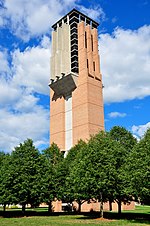Penny W. Stamps School of Art and Design

The Penny W. Stamps School of Art and Design is the school of art and design of the University of Michigan located in Ann Arbor, Michigan. The school offers graduate and undergraduate degrees in art and design. Established as an independent unit in 1974, A&D is one of 19 schools and colleges at the University of Michigan. It is fully accredited by the National Association of Schools of Art and Design. The Stamps School of Art & Design's academic programs and projects focus on generating new creative work, integrating the cultures of art and design, and engaging with the University, region, and national and international communities. In 2012, it was named for Penny and E. Roe Stamps in honor of their longtime support of the school, which included a $32.5 million gift in September 2012.
Excerpt from the Wikipedia article Penny W. Stamps School of Art and Design (License: CC BY-SA 3.0, Authors, Images).Penny W. Stamps School of Art and Design
Bonisteel Boulevard, Ann Arbor
Geographical coordinates (GPS) Address Nearby Places Show on map
Geographical coordinates (GPS)
| Latitude | Longitude |
|---|---|
| N 42.29 ° | E -83.717277777778 ° |
Address
Art & Architecture Building
Bonisteel Boulevard 2000
48109 Ann Arbor
Michigan, United States
Open on Google Maps








